Patrones Armónicos
)
Índice
PUNTOS CLAVE
¿QUÉ SON LOS PATRONES ARMÓNICOS?
PROBLEMAS CON LOS ARMÓNICOS
TIPOS DE PATRONES ARMÓNICOS
¿POR QUÉ SON TAN POPULARES LOS PATRONES ARMÓNICOS EN EL TRADING FOREX?
CÓMO IDENTIFICAR Y DIBUJAR PATRONES ARMÓNICOS
CÓMO COMENZAR A OPERAR CON PATRONES ARMÓNICOS
CONCLUSIÓN
PREGUNTAS FRECUENTES
Los patrones armónicos son un aspecto fascinante del análisis técnico en el trading armónico de forex, ofreciendo a los traders una forma única de identificar posibles reversiones del mercado utilizando formaciones geométricas de precios. Al utilizar ratios de Fibonacci, estos patrones ayudan a los traders a pronosticar futuros movimientos de precio con mayor precisión. Desde el popular patrón armónico mariposa hasta el intrincado patrón armónico murciélago, el trading armónico ofrece un conjunto diverso de herramientas para detectar tendencias del mercado.
En este artículo, exploraremos las ventajas de los patrones armónicos, discutiremos las diferencias entre los patrones armónicos alcistas y bajistas, y proporcionaremos información sobre cómo la mayoría de traders armónicos utilizan estos patrones. Ya seas un trader novato o experimentado, entender estos patrones armónicos populares puede mejorar tu estrategia de trading y análisis del mercado.
Puntos Clave
- Los patrones armónicos utilizan ratios de Fibonacci para proporcionar señales de trading precisas y confiables que ayudan a los traders a hacer predicciones de mercado más mejoradas.
- Algunos patrones comunes incluyen el murciélago, el cangrejo, el tiburón, la formación ABCD y otros.
- Aunque son poderosos, los patrones armónicos requieren identificación cuidadosa y gestión de riesgo para navegar la volatilidad del mercado de manera efectiva.
¿Qué son los Patrones Armónicos?
Los patrones armónicos son formaciones complejas de gráficos utilizadas en el análisis técnico para pronosticar cambios de precio en los mercados de acciones y forex. Estas formas se basan en niveles de Fibonacci para señalar posibles reversiones o continuaciones de tendencia en un gráfico. Existen numerosos patrones armónicos, cada uno caracterizado por proporciones y reglas únicas. Ejemplos como los patrones Gartley, Murciélago, Mariposa y Cangrejo se ven frecuentemente.
Aquellos que saben cómo dibujar patrones armónicos pueden identificar puntos de entrada y salida con riesgo mínimo, resultando potencialmente en trading rentable de patrones armónicos. Al examinar los movimientos exactos de precio que crean estos patrones, los traders pueden predecir el comportamiento del mercado más efectivamente que otras técnicas. Sin embargo, es importante considerar que aunque los patrones armónicos son efectivos en varias situaciones, no son completamente confiables. El aprendizaje continuo y la práctica son esenciales para el trading exitoso de estos patrones armónicos.
¿Qué es una Secuencia de Fibonacci?
La secuencia de Fibonacci es una serie de números donde cada uno es la suma de los dos precedentes, comenzando con 0 y 1. Esta secuencia genera la "proporción áurea", una relación única entre los números que aparece frecuentemente en la naturaleza, arte, arquitectura y mercados financieros. En el trading, los ratios de Fibonacci son cruciales para identificar potenciales niveles de soporte y resistencia esenciales en la predicción de movimientos del mercado.
Al entender y aplicar los principios de la secuencia de Fibonacci, los traders pueden mejorar la precisión de sus predicciones y aumentar la rentabilidad del trading de patrones armónicos.
Problemas con los Armónicos
Aunque las ventajas de los patrones armónicos superan sus desafíos, los traders deben estar conscientes de los inconvenientes. Un problema mayor es la alineación precisa requerida con los ratios de Fibonacci. Por ejemplo, patrones como el Gartley alcista u otros patrones complejos dependen fuertemente de niveles exactos de retroceso de Fibonacci, como 61.8% o 78.6%, para identificar potenciales movimientos de precio. Cualquier desviación de estas mediciones precisas puede llevar a predicciones inexactas.
Otro desafío radica en identificar correctamente las diferentes etapas del patrón, como la etapa AB o la etapa BC. Identificar mal estas etapas puede resultar en evaluaciones incorrectas de niveles de soporte y resistencia, que son cruciales para establecer objetivos de pérdida y ganancia. Esto también puede impactar la decisión de tomar una posición larga o corta en el mercado. Por ejemplo, en un patrón bajista, un punto D incorrecto puede indicar falsamente una reversión de tendencia, llevando a los traders a entrar en una posición en la dirección equivocada.
Además, la estructura compleja de los mercados financieros permite la aparición de patrones a través de diferentes marcos temporales y tamaños. Esto podría crear desafíos para diferenciar entre un ligero retroceso y una formación de continuación o una reversión mayor en la tendencia. Consecuentemente, los traders podrían confundir una breve reversión de tendencia con una continuación de la tendencia principal, resultando en potenciales pérdidas financieras.
La necesidad de una plataforma de gráficos precisa que pueda trazar efectivamente cuadrículas y secuencias de Fibonacci también es crucial. Sin herramientas adecuadas, los traders pueden encontrar desafiante dibujar estas formas geométricas con precisión, complicando aún más el análisis de patrones armónicos.
Tipos de Patrones Armónicos
Hay muchos patrones armónicos diferentes. Cada uno de estos patrones puede señalar tendencias de mercado alcistas o bajistas. Consideremos los más comunes de ellos.
El Gartley
El patrón Gartley, introducido por H. M. Gartley en los años 1930, es un patrón de gráfico armónico prominente en el análisis técnico. Se utiliza para identificar posibles reversiones en las tendencias del mercado. El patrón se construye sobre niveles de retroceso de Fibonacci, creando una secuencia visual que los traders pueden reconocer. En un Gartley alcista, el patrón se asemeja a una forma de 'M', sugiriendo una oportunidad de compra en el punto final, D. En contraste, un Gartley bajista aparece como una 'W', indicando una oportunidad de venta en el punto D.
La formación incluye cinco puntos clave: X, A, B, C y D. El segmento AB típicamente retrocede 61.8% de XA, BC retrocede 38.2%-88.6% de AB, y CD retrocede 78.6% de XA. Entender estos niveles de retroceso permite a los traders anticipar reversiones del mercado y planificar estratégicamente sus operaciones.
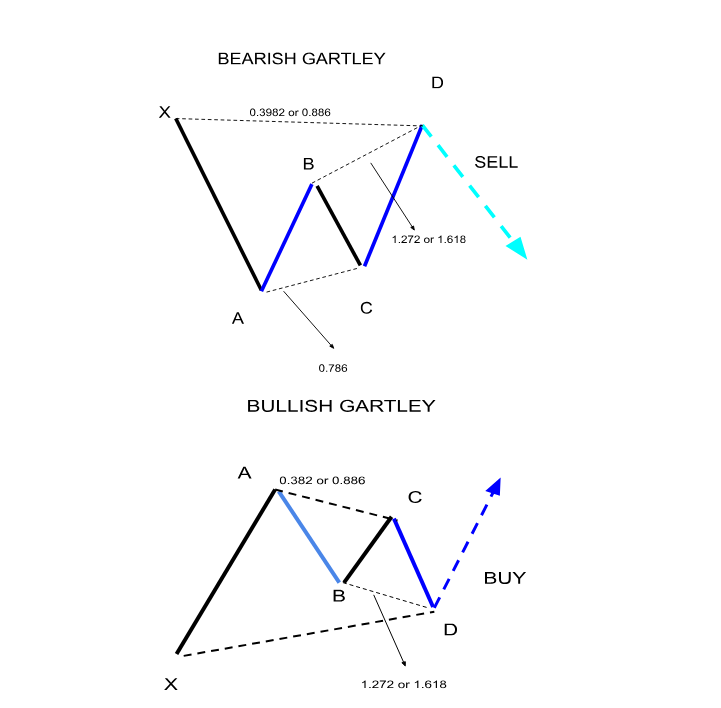
La Mariposa
El patrón Mariposa es un patrón armónico notable en el análisis técnico, usado para pronosticar posibles reversiones en las tendencias del mercado. Incluye cinco puntos críticos (X, A, B, C, D) y cuatro etapas, cada una adhiriéndose a niveles específicos de retroceso y extensión de Fibonacci.
El patrón comienza con una etapa XA, seguida por un retroceso al punto B, usualmente 78.6% del movimiento XA. La siguiente etapa, BC, retrocede entre 38.2% y 88.6% de AB. Finalmente, CD se extiende desde 1.618% hasta 2.618% de AB, llevando al punto D. Este punto marca la zona de reversión potencial. En esta zona, los traders deciden comprar en un escenario alcista o vender en uno bajista, basándose en la formación del patrón.
El patrón Mariposa es valioso por su capacidad de resaltar puntos de giro significativos, ofreciendo a los traders oportunidades ventajosas de riesgo-recompensa al anticipar el final de las tendencias prevalecientes. Entender e identificar este patrón puede mejorar la estrategia de un trader proporcionando puntos de entrada y salida más claros.
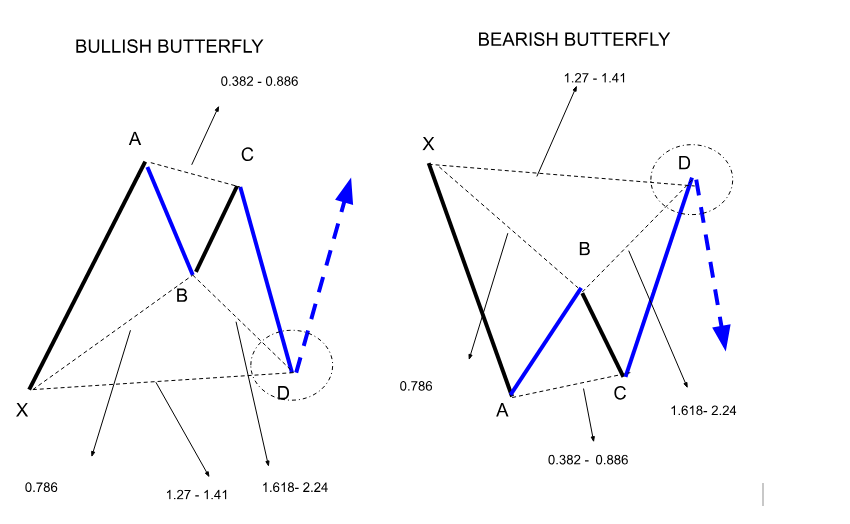
El Murciélago
El patrón Murciélago es un patrón de trading armónico usado para identificar oportunidades de negociación potenciales cuando una tendencia se revierte brevemente antes de continuar en su dirección original. Incluye cinco puntos (X, A, B, C, D) y sigue ratios específicos de Fibonacci. En este patrón, la etapa AB retrocede 38.2% a 50% de la etapa XA, mientras que BC retrocede entre 38.2% y 88.6% de AB.
La etapa CD final se extiende desde 1.618% hasta 2.618% de AB. Este patrón es notable por su potencial de ofrecer puntos de entrada a precios favorables, ya sea para posiciones largas en configuraciones alcistas o posiciones cortas en configuraciones bajistas. El patrón Murciélago se asemeja a las alas de un murciélago en el gráfico y proporciona información valiosa para estrategias de trading.

El Cangrejo
El patrón Cangrejo, creado por Scott Carney, es famoso por su capacidad de pronosticar reversiones del mercado. Esta formación es notable por usar la extensión de Fibonacci para identificar la Zona de Reversión Potencial (PRZ), donde se anticipa un cambio en el movimiento de precio. El patrón Cangrejo tiene el potencial de ser alcista o bajista, determinado por su posicionamiento.
En un patrón Cangrejo alcista, se anticipa que el mercado cambie de dirección hacia arriba una vez que termine de formarse. Un Cangrejo bajista, a su vez, indica una reversión en la dirección descendente. El desarrollo del patrón está determinado por ratios particulares de Fibonacci, siendo el más significativo la extensión 1.618 de la etapa XA utilizada para identificar la PRZ.
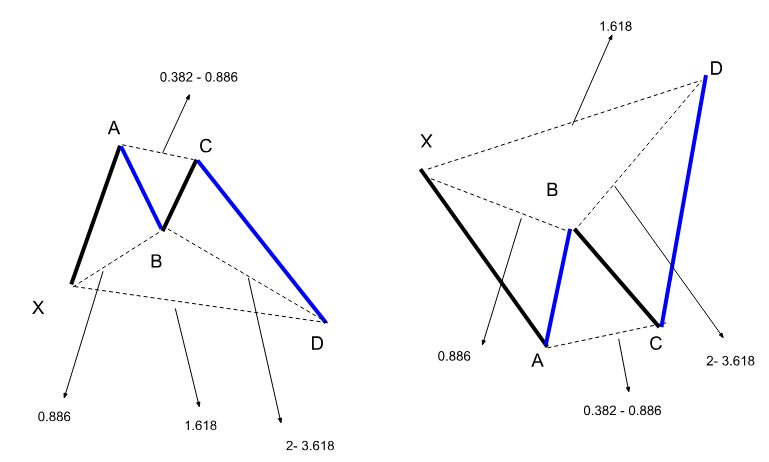
El Tiburón
El patrón Tiburón es distintivo entre las formaciones armónicas debido a su forma especial de etiquetado usando puntos O, X, A, B y C. Sigue una secuencia comenzando con O, luego moviéndose a X, A, B y finalmente C, formando una estructura única. Los traders usan ratios específicos de Fibonacci para reconocer un patrón Tiburón: OX debe variar desde 1.13 hasta 1.618 de XA, y BC debe estar entre 1.618 y 2.24 de OX. Los precios usualmente se revierten en el punto C, comúnmente el punto de entrada de la operación.
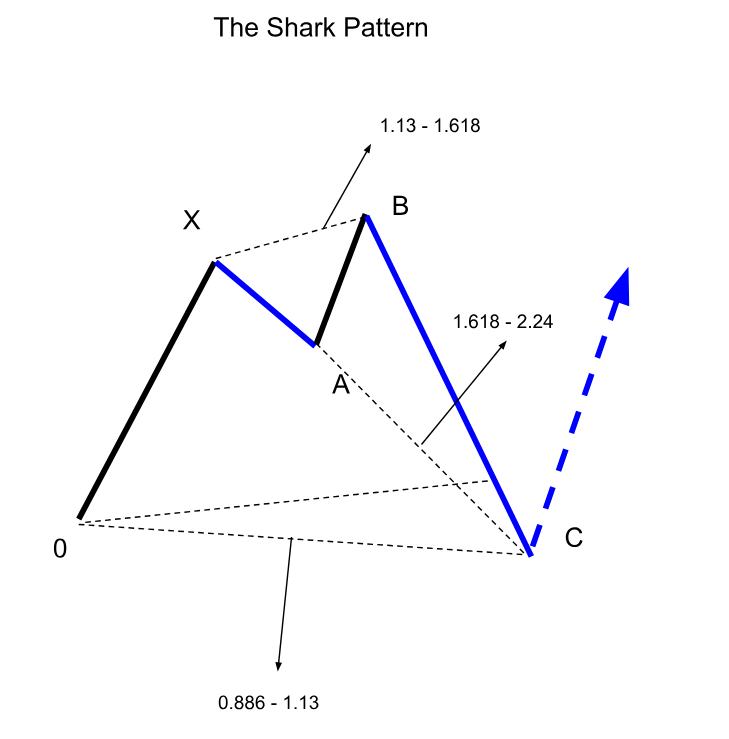
El Cypher
El patrón Cypher consiste en cinco puntos clave etiquetados X, A, B, C y D, creando una forma única que ayuda a los traders a identificar posibles reversiones. La formación comienza con XA, y luego retrocede al punto B, que necesita estar entre 38.2% y 61.8% de XA. Entonces, la estructura continúa al punto C, alcanzando entre el 113% y el 141.4% de XA. Finalmente, suele completarse en el punto D, que comúnmente se encuentra en el nivel de retroceso del 78.6% de XC.
Esta formación de precio puede sugerir sentimiento de mercado positivo y negativo, ofreciendo adaptabilidad en diferentes ambientes de mercado. Los traders buscan una entrada de operación en el punto D, donde la volatilidad frecuentemente resulta en cambios sustanciales de precio.
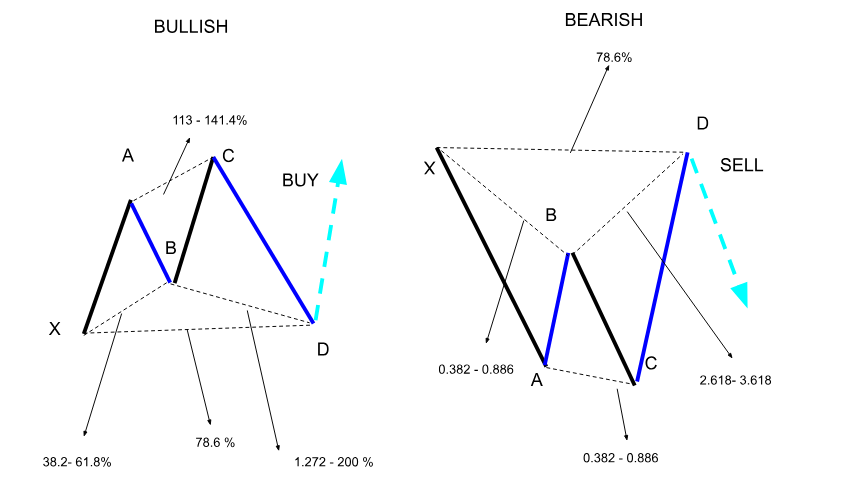
El Patrón ABCD
El patrón ABCD, conocido por su estructura clara y naturaleza predecible, es considerado uno de los patrones armónicos más fáciles pero más poderosos. Está compuesto de dos etapas iguales: un movimiento impulsivo (AB) seguido por un movimiento correctivo (BC), y luego otro movimiento impulsivo (CD) en la dirección opuesta de AB. Los traders usualmente utilizan ratios de retroceso de Fibonacci para reconocer este patrón: la etapa BC generalmente retrocede entre 61.8% a 78.6% de la etapa AB, mientras que la etapa CD típicamente iguala la longitud de la etapa AB.
Una característica clave del patrón ABCD es la Zona de Reversión Potencial (PRZ), donde se espera que termine la etapa CD, señalando una posible reversión. Esta zona de reversión, definida por ratios precisos de Fibonacci, proporciona a los traders un punto óptimo de entrada de operación.
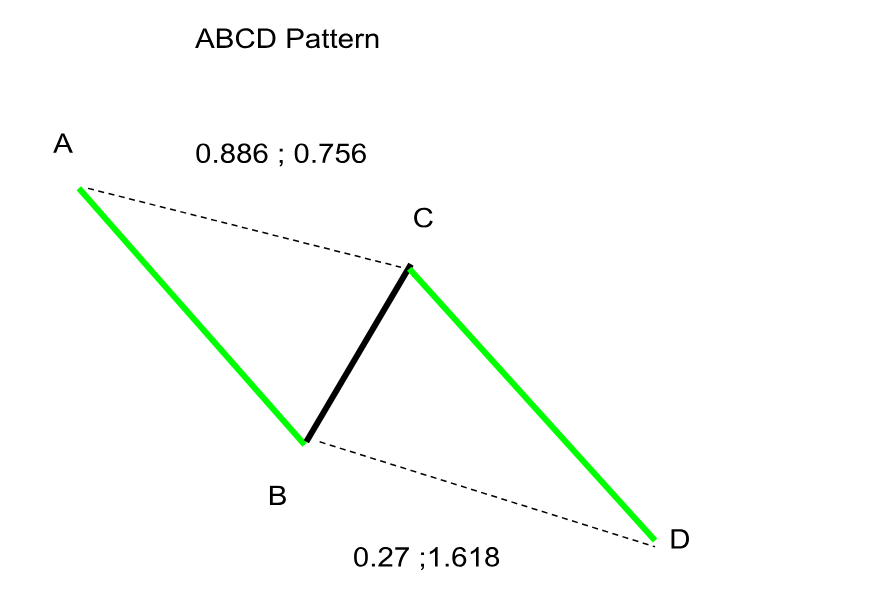
El Patrón Cangrejo Profundo
El patrón Cangrejo Profundo consta de cinco puntos: X, A, B, C y D. La formación comienza con el tramo XA, seguido de un retroceso hasta el punto B, el cual debe representar un retroceso de Fibonacci del 88.6% de XA. La etapa BC se extiende luego entre el 38.2% y el 88.6% de AB, preparando el escenario para la etapa crítica CD.
Esta última es la característica más distintiva del patrón Cangrejo Profundo, ya que se extiende entre el 261.8% y el 361.8% del tramo XA. Esta expansión lleva a la Zona de Reversión Potencial (PRZ) en el punto D, donde los traders anticipan una posible reversión del precio. Además, el punto D suele considerarse un momento óptimo para entrar en la operación.

¿Por qué son tan Populares los Patrones Armónicos en el Trading Forex?
Los patrones armónicos son ampliamente favorecidos en el trading Forex debido a su naturaleza precisa y confiable. Utilizan ratios de Fibonacci para anticipar cambios de precio, dando a los traders puntos precisos de entrada y salida, lo que facilita mitigar riesgos potenciales. Además, su capacidad de reconocer posibles cambios en mercados altamente volátiles como el forex los convierte en instrumentos extremadamente valiosos.
Cómo Identificar y Dibujar Patrones Armónicos
Para identificar y dibujar patrones armónicos de trading, los traders necesitan reconocer si es un mercado bajista o alcista y luego identificar puntos clave de precio en un gráfico, dependiendo del patrón. El siguiente paso es aplicar herramientas de retroceso y extensión de Fibonacci para verificar los ratios del patrón.
Patrones Armónicos Bajistas vs Alcistas: ¿Cuál es la Diferencia?
Los patrones armónicos bajistas indican posibles disminuciones de precio, guiando a los traders a vender posiciones. En contraste, los patrones armónicos alcistas señalan posibles aumentos de precio, impulsando posiciones de compra.
Cómo Comenzar a Operar con Patrones Armónicos
Comenzar a operar con patrones armónicos involucra algunos pasos esenciales.
- Edúcate. Si estás pensando en operar patrones armónicos, entiende a fondo la teoría detrás de ellos y obtén una comprensión clara de sus tipos.
- Elige una estrategia. Decide si adoptar una estrategia bajista o alcista basada en tu perspectiva del mercado.
- Establece objetivos. Establece objetivos claros de pérdida y ganancia para mitigar tus riesgos.
- Identifica puntos de entrada y salida. Usa ratios de Fibonacci para identificar puntos precisos de entrada y salida, asegurando la identificación adecuada del patrón.
- Abre una cuenta de trading. Elige una plataforma de corretaje confiable como J2T que te proporcionará todas las herramientas para el trading de patrones armónicos.
- Practica en una cuenta demo. Gana experiencia y refina tus habilidades en una cuenta demo para practicar trading sin riesgo financiero.
Conclusión
Los patrones armónicos son herramientas precisas para pronosticar movimientos del mercado utilizando ratios de Fibonacci para identificar zonas probables de reversión. Patrones principales como Tiburón, Cypher, ABCD y Cangrejo Profundo ofrecen señales distintas de entrada y salida. Sin embargo, a pesar de ser populares debido a su precisión, los traders deben mantenerse vigilantes de posibles riesgos, como identificación errónea y fluctuaciones del mercado. La combinación de patrones armónicos con otras herramientas de análisis técnico puede proporcionar confirmaciones adicionales para las señales de trading. Practicar con cuentas demo y realizar análisis en profundidad puede reducir estos riesgos y mejorar tus resultados de trading.
Preguntas Frecuentes
¿Qué son los patrones armónicos?
Los patrones armónicos son patrones geométricos que aparecen en gráficos del mercado de valores creados por secuencias de Fibonacci. Al reconocer movimientos particulares de precio y niveles de soporte y resistencia, ayudan a los traders a anticipar cambios en las tendencias, así como ofrecer objetivos de ganancia y control de riesgo.
¿Cuál es el patrón armónico más poderoso?
Muchos creen que el patrón Gartley es el patrón armónico más influyente. El análisis de patrones se utiliza en el mercado de valores para predecir reversiones de tendencia con precisión, usando ratios específicos de Fibonacci para determinar puntos confiables de entrada y salida.
¿Realmente funciona el trading armónico?
La mayoría de los patrones armónicos funcionan efectivamente cuando se alinean con precisión con los ratios de Fibonacci. Ayuda a identificar reversiones de tendencia y establecer objetivos de ganancia, pero su éxito depende del reconocimiento preciso del patrón y las condiciones del mercado en los mercados financieros. Los patrones armónicos han demostrado ser exitosos cuando se aplican correctamente y con la disciplina adecuada.
¿Qué es el patrón ABCD de armónicos?
El patrón ABCD es un patrón armónico simple donde las etapas AB y CD son de la misma longitud, y la etapa BC retrocede una porción de AB. Se utiliza para identificar posibles reversiones de tendencia y establecer objetivos de ganancia.
¿Cuáles son los patrones armónicos para principiantes?
Los principiantes a menudo comienzan con patrones más simples como el ABCD y Gartley, que usan ratios básicos de Fibonacci y son más fáciles de identificar. Estos patrones ayudan a entender los principios fundamentales del análisis de patrones armónicos en mercados financieros.
¿Cuáles son los patrones armónicos más populares?
Los patrones de trading armónicos más populares incluyen los patrones Gartley, mariposa, murciélago y cangrejo. Estos patrones son ampliamente utilizados por su capacidad de predecir reversiones de tendencia y establecer objetivos precisos de ganancia utilizando ratios de Fibonacci en el mercado de valores.